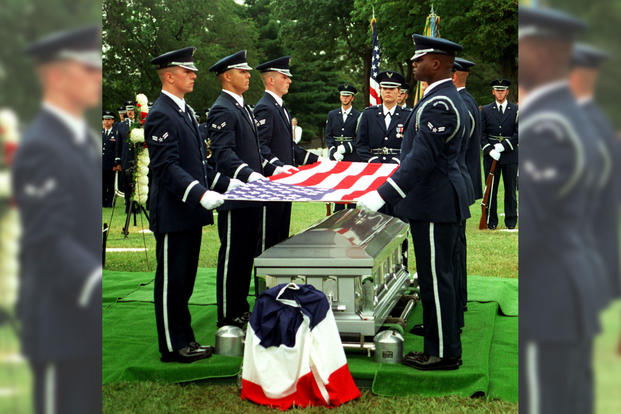After Years As Vietnam 'Unknown,' Pilot Now Buried At Home
For decades, the United States has honored its wartime dead by designating for burial at Arlington National Cemetery an unknown soldier, one whose anonymous tomb represents all the dead comrades and honors all their deeds.
For 14 years, the remains of Air Force 1st Lt. Michael Joseph Blassie lay beneath the Tomb of the Unknowns in Arlington. The nature of combat in Vietnam and advances in forensic medicine had made it difficult for officials to bury a Vietnam unknown. Unidentified remains from that war had been analyzed over a decade and a half. No one wanted to inter someone who might eventually be identified.
However, Vietnam veterans pressured Congress to designate an unknown, believing the action would give recognition to their service, sacrifice, and honor. In the early 1980s, officials chose the set of remains coded "X-26" to be interred in the Tomb of the Unknowns. As is standard, all records pertaining to these remains were destroyed. The Vietnam unknown was laid to rest in Arlington National Cemetery with full military honors, beneath the headstone that reads, "Here rests in honored glory an American soldier known but to God." President Ronald Reagan bestowed the Medal of Honor upon the Vietnam unknown. "We write no last chapters, we close no books," Reagan said. "We put away no final memories."
The president meant to assure families of soldiers with MIA status that their loved ones would not be forgotten, but his words were prescient of the Vietnam unknown's fate. "X-26" remained in Arlington with his unknown comrades, watched by the solemn Old Guard, until 1998, when new questions about Blassie's whereabouts surfaced. His sister Pat described the evidence succinctly: "The trail leads to the tomb." In May 1998, the remains were disinterred for mitochondrial DNA "fingerprinting." Advances made since the early 1980s had made it possible to identify the remains, which consisted of only six bones -- far below the usual 80 percent of a corpse required for burial at Arlington.
Blassie, a decorated pilot, was 24 when he died in May 1972. His 138th combat mission ended near An Loc, South Vietnam, when the wing was blasted off his plane by enemy fire. The aircraft went down in flames.
On July 10, 1998, Michael Blassie's body was released to his family. They brought him home for burial in Jefferson Barracks National Cemetery near St. Louis. There, a plaque holds words from the Gettysburg Address: "We can not dedicate -- we can not consecrate -- we can not hallow this ground. The brave men, living and dead, who struggled here have hallowed it far above our poor power to add or detract."















